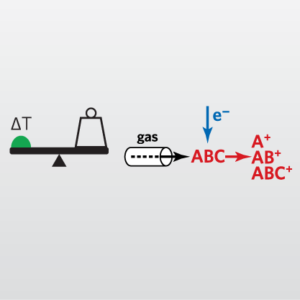Thermogravimetry Evolved Gas Analysis (TG/EGA)
Home » Our Techniques » Physical/Chemical Characterization » TG-EGA
Thermogravimetry Evolved Gas Analysis or TG/EGA is an analytical technique that can characterize weight changes associated with decomposition, oxidation and any other physical or chemical changes that result in sample weight loss or gain. During the experiment, a transfer system actively moves the gases evolved during these processes to an instrument capable of providing chemical characterization of the volatiles and pyrolysis products.
The “TG” of TG/EGA is identical to standard thermogravimetric analysis (TGA). Heating a sample in a controlled gas atmosphere using a programmed temperature sweep or isothermal hold enables the study of physical or chemical processes that result in sample weight loss or gain. Analysis of the evolved gases is accomplished with Fourier Transform Infrared spectroscopy (FTIR) or Mass Spectrometry (MS). With either of these instruments, a series of peaks (spectrum) is obtained that can be compared to spectral reference databases for identifying the chemistries present in the off-gassing components.
TGA-FTIR: The FTIR spectra of gaseous products obtained by TGA-FTIR can be compared to spectral reference databases for identifying the chemical class or family of the unknowns. In many cases, the chemistries can be narrowed down to specific compounds.
TGA-MS: TGA-MS provides a sensitive method for analyzing TGA gaseous products in detail. Gas molecules are transferred from the TGA to the mass analyzer, where electron impact converts them to ions, which are then sorted by mass/charge (m/z) ratio. The electron impact causes most of the original gas products to form fragment ions, which are charged pieces of the original molecules. The output chart is a “mass spectrum” displaying the ion current (intensity) versus m/z. Tentative identification of the original gas products can be performed in two steps: (1) assigning the structure of the fragment ions using the mass data, and (2) correlating the assigned fragment structures with known fragmentation patterns of specific molecules.
Ideal Uses of TG/EGA
- Thermal stability studies
- Monitoring mass changes of materials under controlled gas atmosphere and temperature: volatiles, reactive gas evaluation, filler content, compositional analysis, material identification
- Phase transitions of metals and alloys
- Qualitative analysis of phase transitions: melting, Tg, crystallization
- Determining the effect of oxidative or reductive atmospheres on materials
- Analysis of polymers, organic and inorganic materials
Strengths
- Simultaneous thermogravimetric analysis (TGA) and characterization of evolved chemical species
- Small sample size
- Analysis of solids and liquids with minimal sample preparation
- Detection of multiple mass loss thermal events from physical and chemical changes of materials
Limitations
- FTIR does not detect non-polar molecules, such as H2, N2, O2
- FTIR spectral identification of product gases may be limited to chemical family or class
- Secondary gas-phase reactions can complicate identification of product gases
TG/EGA Technical Specifications
- Temperature Range: ambient to 1000°C
- Maximum Sample Weight: 1 gram
- Controlled Heating Rate: 0.1 to 100°C/minute
- Isothermal Temperature Accuracy: +/- 1%
- Weighing Precision: +/-0.01%
Would you like to learn more about using TG/EGA?
Contact us today for your Thermogravimetry Evolved Gas Analysis needs. Please complete the form below to have an EAG expert contact you.
